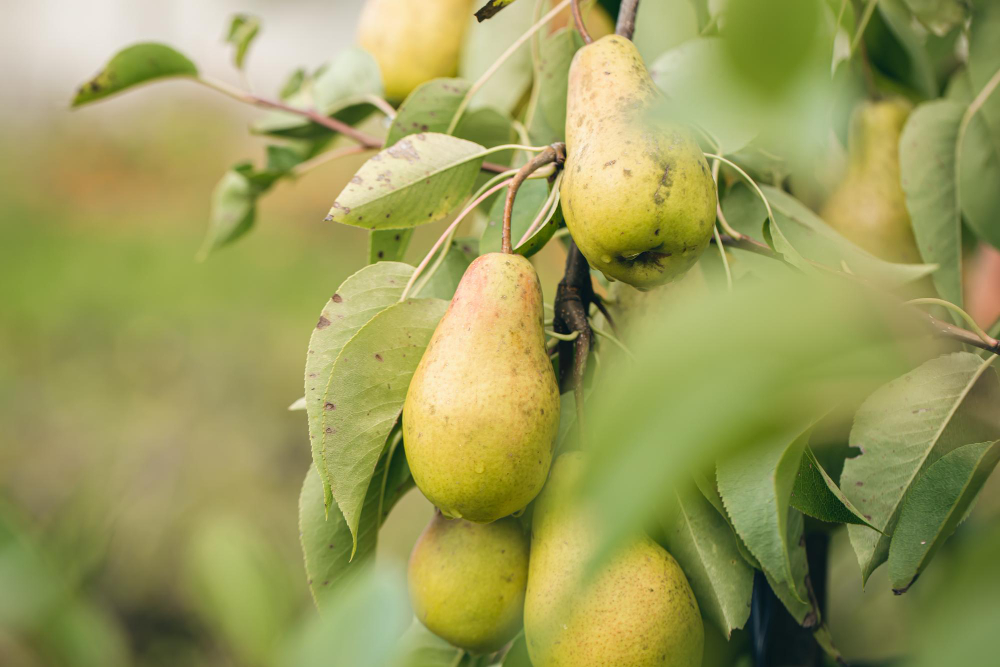Atulya Vanam's Mighty Pear Tree: Exploring its Medicinal Marvels and Culinary Delights Across Healing Traditions
The Pear tree (Pyrus spp.) stands as a symbol of grace and nourishment, offering not only its succulent fruit but also a plethora of therapeutic benefits through its leaves, fruit, bark, roots, and flowers.
In this comprehensive blog, we embark on an enlightening journey to explore the diverse uses of the Pear tree across various medical systems, including Modern Medicine, Ayurveda, Unani, Homeopathy, Siddha, and its versatile applications. Additionally, we delve into the distinctive Pear varieties thriving in India.
Medicinal Value
Modern Medicine:
Fruit (Pear): Beyond its crisp texture and delicate sweetness, Pears provide a source of dietary fiber, vitamins, and minerals that contribute to digestive health and overall well-being.
Flavonoids: Pears contain flavonoids, such as quercetin and kaempferol, which possess antioxidant properties and have potential health benefits.
Ayurveda:
Fruit (Pear): Ayurveda acknowledges the cooling nature of Pears, using them to balance pitta dosha. Pears are believed to promote digestion, enhance vitality, and offer hydration.
Leaves: Pear leaves are used in Ayurvedic practices for their potential in managing conditions like diabetes and inflammation.
Unani:
Fruit (Pear): Unani appreciates Pears for their nutritive value, considering them a source of energy and overall wellness.
Homeopathy:
Fruit (Pear): While not a primary remedy, Homeopathy may incorporate Pear into preparations targeting specific symptoms or conditions.
Siddha:
Fruit (Pear): In Siddha medicine, Pears are believed to have cooling properties, promoting digestion and balance.
General Uses
Culinary Excellence: Pears’ unique texture and flavor make them a popular addition to salads, desserts, and even savory dishes.
Infused Water: Pear slices can be added to water for a refreshing and subtly flavored drink.
Natural Remedies: Pear leaves, bark, and other parts may be used in traditional remedies for various ailments, including digestive issues.
Ornamental Value: Pear trees contribute to landscaping with their graceful form and spring blossoms.
Fiber and Arts: Pear wood is used in crafting furniture, utensils, and even musical instruments.
Pear Varieties in India
Hosui Pear: Known for its juicy and sweet taste, Hosui Pears are often consumed fresh or used in culinary creations.
Bartlett Pear: With its distinctive bell shape and buttery texture, Bartlett Pears are favored for both fresh consumption and cooking.
Anjou Pear: Recognized for its smooth skin and versatile taste, Anjou Pears are often enjoyed in salads and desserts.
Seckel Pear: Small and flavorful, Seckel Pears are cherished for their intense sweetness and petite size.
Concorde Pear: Characterized by its elongated shape and mild flavor, Concorde Pears are versatile in both sweet and savory dishes.



More about Jackfruit
Pear trees (Pyrus spp.) are captivating and unique trees with a range of extraordinary qualities. Here are some intriguing facts about pear trees:
- Ancient History: Pear trees have been cultivated for thousands of years and are among the world’s oldest cultivated fruit trees.
- Delightful Diversity: There are over 3,000 varieties of pears, each with distinct flavors, textures, colors, and sizes.
- Nutrient-Rich: Pears are rich in dietary fiber, vitamins (such as vitamin C and vitamin K), and minerals (like potassium), contributing to potential health benefits.
- Subtle Sweetness: Pears are known for their delicate and slightly sweet flavor, which varies among different varieties.
- Culinary Versatility: Pears can be enjoyed fresh, baked into desserts, added to salads, pickled, and even used to make beverages like pear cider.
- Cultural Significance: Pears hold cultural significance in various societies, often associated with longevity, prosperity, and well-being.
- Unique Shapes: Pears come in various shapes, including round, oval, and elongated, with some varieties featuring distinctive features like a “waist.”
- Harvest Variability: Pears are typically harvested when they are still firm and ripen after picking, making them a convenient fruit to store.
- Medicinal History: In traditional medicine, pears have been used for their potential digestive benefits and as a source of hydration.
- Ornamental Value: Pear trees produce clusters of delicate flowers in spring, adding beauty to landscapes and gardens.
- Fruit for All Seasons: Different pear varieties can be harvested from late summer to early winter, ensuring a continuous supply of fresh fruit.
- Folklore and Symbolism: Pears appear in folklore, literature, and art, symbolizing love, knowledge, and transformation in different cultures.
- Culinary Classics: Pears are featured in classic dishes such as poached pears, pear tarts, and even as accompaniments to cheese plates.
- Culinary Pairings: Pears’ gentle sweetness and subtle flavor make them versatile ingredients in both sweet and savory recipes.
- Propagation Methods: Pear trees can be propagated through grafting, cuttings, and budding, allowing for the preservation of specific traits.
- Historical References: Pears have been depicted in ancient art and literature, including references in works by Roman poets and Chinese writers.
- Artistic Inspiration: The beauty of pear trees in bloom has inspired artists and poets throughout history.
These extraordinary facts highlight the charm and versatility of pear trees, from their diverse varieties and culinary potential to their cultural symbolism and historical significance. Pear trees continue to enchant us with their timeless appeal and the delightful taste of their luscious fruits.
Conclusion
The Pear tree, an embodiment of grace and sustenance, surpasses its role as a fruit-bearer. Its leaves, bark, roots, flowers, and diverse applications intermingle with a tapestry of medical systems and cultural practices. From Ayurveda’s ancient wisdom to modern medical validation, the Pear tree’s virtues flourish. By embracing the amalgamation of traditional knowledge and contemporary exploration, we unveil the countless ways in which the Pear tree enriches our lives—nourishing not only our bodies but also our cultural heritage and environment.
